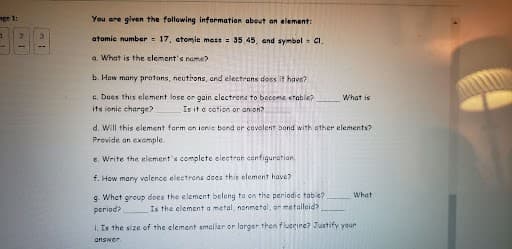You are given the following information about an element: atomic number 17, atomie mass= 35.45, and symbol - Cl. a. What is the element's name? b. How many protons, neutions, and electrons does it have? c. Does this element lose or gain electrons to become erable? its ionic charge? Is it a cation or anion? What is d. Will this element form an ionic bond or covalent bond with other elements? Provide an example e. Write the element's complete electron configuration f. How many valence electrons does this element have? 9. Whet group does the element belong to on the periodic table? period? Is the element a metal, nonmetal, on metallid What i. Is the size of the element smaller or larger then fluctine? Justify your answer
Types of Chemical Bonds
The attractive force which has the ability of holding various constituent elements like atoms, ions, molecules, etc. together in different chemical species is termed as a chemical bond. Chemical compounds are dependent on the strength of chemical bonds between its constituents. Stronger the chemical bond, more will be the stability in the chemical compounds. Hence, it can be said that bonding defines the stability of chemical compounds.
Polarizability In Organic Chemistry
Polarizability refers to the ability of an atom/molecule to distort the electron cloud of neighboring species towards itself and the process of distortion of electron cloud is known as polarization.
Coordinate Covalent Bonds
A coordinate covalent bond is also known as a dative bond, which is a type of covalent bond. It is formed between two atoms, where the two electrons required to form the bond come from the same atom resulting in a semi-polar bond. The study of coordinate covalent bond or dative bond is important to know about the special type of bonding that leads to different properties. Since covalent compounds are non-polar whereas coordinate bonds results always in polar compounds due to charge separation.

Step by step
Solved in 3 steps with 3 images









